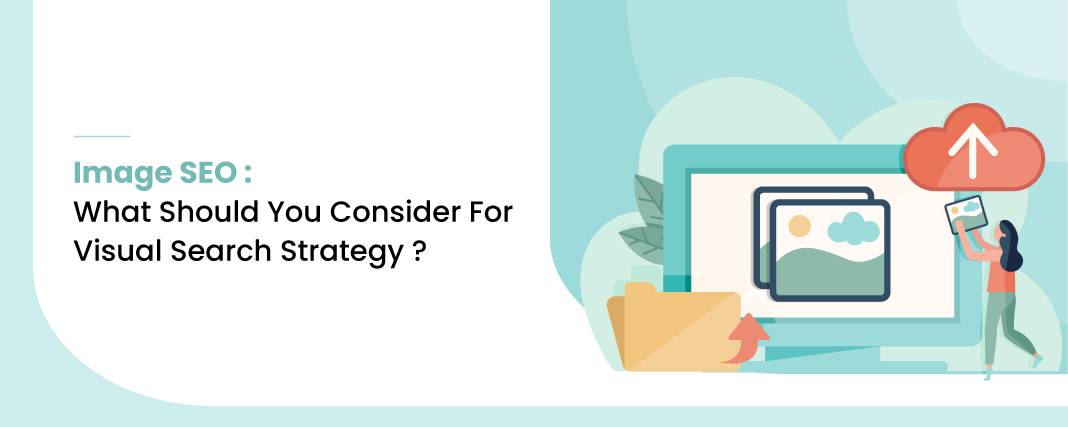Visual searching has been considered as one of the lesser-discussed forms of searching online. And yet, digital marketers have been using it for quite some time now. A visual search strategy can help marketers build their brand on various popular search engines and social media platforms, including Pinterest, Bing, Snapchat, Amazon, and Google.
So let’s dive deep into image SEO!
What Is Visual Search?
Visual search makes use of artificial intelligence technology for people to search using real-world imagery, rather than the usual text search.
The visual search typically uses screenshots, internet images, and photographs to search online.
Modern visual search technology, on the other hand, uses artificial intelligence to understand the content and context of these images for returning related results.

An Example
When you try to photograph an object using Google Lens, the software is programmed to identify the object within the picture. This helps provide information and present search results to the user.
Of late, particularly this technology has been proven useful for eCommerce stores and online brands. By implementing a well-optimized content strategy, e-stores also stand the chance of being part of the returned search result for a user.
So, any company that appears as the result of a popular search query has the opportunity to make a lot of money.
The Difference Between Visual Search and Image Search
To begin with, visual search is part of the umbrella term ‘sensory search’, including searching online through text, voice, as well as vision.
Both image and visual searches are based on the lines of imagery, but there’s an important difference between the two. People use words to carry out an image search and use an image to conduct a visual search online.
For those who don’t know, visual search Google has been made available to the public for almost 20 years now. Google was the first one to introduce this search format way back in July 2001.
Fun Fact
The reason behind developing a full-fledged visual search was that Google search engine was unable to handle the number of people searching for a photograph of Jennifer Lopez in a popular green dress.
Visual search requires a solid combination of computer vision and machine learning technology to deliver optimum results.
- Computer vision allows the machines to see and interpret what they are seeing before they come to a decision of what to do with that information.
- We know how computer vision has been around for a long-time. However, it was only until the advancement of machine learning that it was made useful for visual search.
- Machine learning can help provide information that computer vision requires for understanding the contents of the image.
Google Lens allows the technology to cross-reference information available within the Google Knowledge Graph. Many popular platforms utilize different software to support their versions of image recognition.
The Importance of Using Images and Visuals
Statistically speaking, it is much easier and quicker to process a visual signal than reading a full sentence of a paragraph. Images are known to pass more information within a short span of time because as they say it, an image is worth a thousand words.
In fact, research also indicates that the human brain can process images 60,000 times faster compared to texts. Here are the benefits of using images for SEO purposes:
1. Increasing website traffic
As per the findings of the latest forecast by the Cisco Visual Networking Index, statistics reveal that by 2021, videos will account for over 82% of all consumer Internet traffic worldwide.
Video and infographic production costs more money than content, but it’s an important investment to attract more customers to your website or social channels. If you are hesitant to make images and videos a part of your content marketing strategy, you will be losing a lot in terms of website traffic. Images, GIFs, and videos have been the rage these days, so it is high time to embrace them.
2. Engaging customers through visuals
If you are wary of adding standalone visual content, including visuals in your text-heavy material can make your online content marketing campaigns more interesting and effective in keeping your audience engaged.
Instead of having long blocks of text, you can have several images that will make your content a lot easier to skim through and understand.
BuzzSumo data suggests that any Facebook post with images had 2 to 3 times more engagement than those without it.
Stats also mention that including images to Twitter updates has resulted in 150% more retweets than having plain text updates.
In short, visual content can help you keep your site visitors on your landing page. This can help you raise the click-through rates to other parts of your website and also improve any visitor’s engagement with your brand.
3. Improving conversion rates
Improved brand awareness, higher website traffic, and enhanced customer engagement from a successful visual content strategy directly lead to increased lead generation and sales.
Image and video content are essential driving factors in the buyer’s journey. The 2018 Wyzowl Video Marketing Statistics Report how video has become ‘a decisive factor’ that can convince consumers to purchase, download, or recommend a product online.
The report also found how videos influenced 81% of viewers to buy a product or service. It also states that 95% of people learn more about a product or service with graphics or watching a simple explainer or how-to video.
4. Using graphics to maintain the audience’s attention
Nowadays, it is pretty hard to grab people’s attention because everyone has a computer in their pockets. With the world at their fingertips, the second users are bored, they’re going to land upon something else. The quickest way of making your audience bored is by throwing a bunch of text/bullet points upon their tiny screen.
Many traditional companies may find it tempting to blame technology, social media, or the young gen for such a short attention span. Before you make any mistake, you can try using more visuals that can help with your presentation.
It is your responsibility to engage your audience, and we have already established that human brains prefer visuals over text. With too much text on your website, you’re pushing people to your competitors.
5. Images for understanding the material
A Text-heavy website or a social media post doesn’t charm your audience and probably they won’t pay attention. How are they ever going to understand what products you are offering? This is why using images is so important.
The human brain processes visuals much quicker than text because of working memory and cognitive load. This space is reserved for processing, thinking, and trying to fit new bit of information. The best way to ensure your audience stays longer on your site is to have less text and more pictures.
Optimizing for Images for Online search (Image SEO)

Now that we have discovered tempting benefits for getting involved in the visual search bar, it is time to understand how to appear in visual search and the best practices that you can stick to.
If you are looking to incorporate more graphical content online, here are a few tips on performing image SEO and get started.
1. Using Structured Data
When you want to add content to a website, you have to provide search engines as much information as possible. You can do this through structured data for images, which can help your site appear in Google’s rich snippets.
Visit this link to read about Google’s general structured data guidelines. Know more about the type of structured markup you can add by going to the official schema.org image page.
Google typically recommends JSON-LD, and here’s an example of it:
<script type=”application/ld+json”> { “@context”: “https://schema.org/”, “@type”: “ImageObject”, “url”: “https://example.com/photos/1×1/black-labrador-puppy.jpg”, “license”: “https://example.com/license”, “acquireLicensePage”: “https://example.com/how-to-use-my-images” } </script>
Note: All the license details will be visible in Google’s search results in the form of a badge.
2. Adding Alternative Text
Also known as “alt descriptions” and “alt tags”, the alternative text is visible instead of an image in case it is unable to load on the screen.
Search engines predominantly read the alternative text as it helps them understand the meaning and context of an image. Individuals using screen readers will also require alt text to understand what the image is all about.
Did you know
Target, Domino’s Pizza, and The Pokémon Company have faced serious lawsuits by customers who were unable to navigate their websites due to the lack of alternative text.
Ensure that the alternative text you add to your website is honest, concise, and well written. If you’ve uploaded an image of a man holding a protein shake bottle, your alternative must-read somewhat like this- “Young, healthy man is holding a protein shake bottle after an intense workout session.”
3. Using Descriptive Filenames
Context is very important when you get your images to the audience. Though it is common for image files to have names like – “IMG_23423.jpg”, we recommend giving as much information as possible here.
So, for the protein shake example, rename the image to rename it to “man-with-protein-shaker.jpg” instead of “IMG_23423.jpg”.
4. Having an Image Sitemap
If you have an image sitemap, the chances of your images being discovered by search engines drastically increase. This is especially true if your images are loaded with Javascript. An image sitemap can help Google identify, crawl, and index your images seamlessly well.
5. Using Appropriate File Types & Image Sizesp
Make sure your visual content is well optimized by considering the file size of your image. If not, this may affect how fast your site loads to users. We all know how a slow loading speed can quickly disperse any potential customers/lead that you may have had otherwise.
These three sites are recommended compressing images
- TinyPNG
- CompressNow
- Optimizilla
While discussing the image size, it is crucial to consider the type of files to upload on a website. Google Images, which are often used as a benchmark for plenty of online platforms, supports these file types
- BMP
- GIF
- JPEG
- PNG
- WebP
- SVG
Remember each file type has its set of advantages and disadvantages. Also, a few types, such as GIFs, may not be in line for some commercial platforms.
Bonus Elements to Consider
The above recommendations revolve majorly around images. However, it is also important to know that just like SEO, there are many elements you must consider to appear in visual search results. These include:
Best Practices for Using Images in Your Content
If you are unable to understand the best practices for including images in your blog posts, keep reading!
1. Break up the text
People typically use paragraphs to separate points, so that it becomes easier for the reader to understand. Just like that, experts use pictures to separate points and make the text appealing and understanding.
So if your wall of text isn’t that long, and yet it looks too difficult to read, people are not going to bother reading it. Use images to break the monotony of a dry online article.
2. Use clear images
If you are unable to get high-quality images, you might want to start doing that now. And though images, in general, are important, it’s mandatory to use high-quality ones only.
Including poor images may be worse than using no images at all because that can frustrate the reader and tarnish your brand image.
3.Using legal images
It is not acceptable to take any random image from the Internet and paste them on your blog post. In fact, there are companies that may charge you a fee for using their images.
Every time you are taking images online, the first thing to do is find out whether you can legally use them on your blog. At times, despite using a free image, you may have to answer where you got it from. The best bet is to buy images. Sites like Shutterstock can help buy images.
If you want good quality free images available for use without having to attribute anything then visit either Unsplash or Pixabay.
4. Adding screenshots
The images in your blog often act as a visual aid to get your point across to the reader.
If you want to make your message even stronger, try incorporating screenshots in your content. A Chrome browser extension called Awesome Screenshot can help you capture an entire web page easily
5. Using explainer/relevant images
You can also use imagery online to further explain the main crux of your article to the audience.
An example
If you’re writing something about Twitter, getting a photo of a tweet can help the reader understand your thoughts better. Putting up a generic photo of a person on a mobile may not add much value (Don’t forget the image SEO!).
You can use diagrams to put forth complex ideas Try using OmniGraffle to create diagrams and flowcharts; imgflip can help create pie charts. You can also create an infographic to act as a standalone piece of content.
Easy tip
Use your own data and supplement it with external data while putting together your infographic.
Did You Know
Infographics are shared 3 times more on social media because they’re easy to read, presentable, and visually appealing.
Infographics can help showcase data in a less overwhelming fashion. The same information as the text will make the audience’s eyes wander around the screen, hopelessly searching for some concrete material to rely on.
Optimizing Images for Visual Searches
Simply put, for an e-Commerce store, visual search can help prospective leads find their products online. Here are a few ways your business can adopt to optimize for visual search and enjoy more leads.
1. Offering numerous images
Never have a single image of your product on your website. When it comes to online shopping, your buyer should be able to view it from all possible angles.
Multiple images will make sure your leads find your products irrespective of what angle they are viewing your product. Take plenty of photos of your products to ensure your audience finds your website first.
2.Choose high-resolution photos
You need to invest in great photos to attract leads. High-quality photos can help Google process your photo to match the search query quickly.
Don’t use blurry or low-resolution pictures on your site. Such images can frustrate your audience and they may bounce off to your competitors. High-resolution photos will allow your audience to see your product clearly and keep them engaged on your site.
3. Do your keyword research
Keyword research impacts visual search. Keywords can help you get a better description of your product image and they also help your image appear in the relevant results.
Always focus on long-tail keywords that contain three or more words. They are more specific and detailed and can help attract qualified leads to your product.
4. Include captions
Several brands make a huge mistake by thinking their images are self-explanatory. This can’t always be true because, in reality, captions help audiences understand the image better eliminating any scope of doubts.
Captions help describe what’s happening in your photo. They provide the detailing about your product and add more context to your image. Captions can also improve your image’s ranking, so don’t ever miss out on them.
Google Lens & Its Features
Google Lens uses image recognition to navigate through the real world with the help of Google Assistant. You can use this tool to identify images on your camera, which can help gain more information about places, plants, animals, products, landmarks, and other objects. The tool also helps you scan and auto-translate text.

Here are some of its popular features
1. Copy Text from the Real World
Google Lens can copy text from the real world directly.
Just point your camera at the text you want to copy and go to Google Lens mode. Tap on the text for the Lens to highlight it. Next, drag to select whatever you want to copy, and tap on ‘Copy text’.
2. Detect Flowers, Locations, Restaurants, etc.

An example
If you’re out on a walk and you spot an unknown flower, use Google Lens to identify. Just point your camera at the flower, you will have all the information you want at your fingertips!
At times it may not work, so in such a case, just click a picture of it and use the Google Lens feature inside Google Photos.
3. Find Businesses, Add Contacts by Directly Scanning Visiting Cards

Google Lens’ can add contacts by scanning a business card. You can use Google Lens to get directions to a business place by scanning their business card.
Note- This feature only works for businesses that are listed on Google Maps.
4. Scan URLs from PC and Open Them in Mobile
With Google Lens open on your phone, point it at the URL bar on your desktop browser, and tap on the URL. Google will auto-detect the URL text and show the option to ‘go’ to the address in your smartphone.
Note- Web pages with longer URLs won’t fit inside the URL bars. In such a case, you can copy and paste the URL onto the notepad and scan it.
5. Adding Events by Scanning Tickets
With Google Lens keep a track of important events. Just scan the ticket to a movie you booked tickets for, and Google Lens will automatically suggest adding the event to your calendar.
Google Lens Search Statistics
- Images hold for 19% of search queries that take place on Google. Moz
- Images are returned for 34% of search results. Econsultancy
- Google Lens is capable of detecting over 1 billion objects. TechSpot
- Google Shopping ads see a budget increase of 33%, versus a rise of just 3% for text ads. Merkle report, Q3 2018
- Google Lens has been used over 1 billion times. Google
Visual Search Trends
Here are a few visual search trends that will encourage you to dive into visual search Google:
- For the past year, Target has been using Pinterest Lens. WSJ
- Pinterest has combined visual search with a text search to increase its reach.
- Google Search offers an excellent visual experience
Visual Search Statistics
- 62% of millennials can use visual search over different technologies. Visenze
- 21% of advertisers believe visual search is the most important trend for their business in 2019. Marin Software
- 35% of marketers have optimized for visual search in 2020. Search Engine Journal
- 90% of information transmitted to the human brain is visual. MIT
- The human brain can identify images seen for as little as 13 milliseconds. MIT
- The image recognition market will grow to $25.65 billion by 2019. MarketsandMarkets
- 59% think visual information is better than textual information; on the other hand, 41% think textual information is more important. The Intent Lab
- 45% of retailers in the UK now use visual search. Tech HQ
- 36% of consumers have conducted a visual search. The Intent Lab
- When shopping online for clothing or furniture, over 85% of respondents put more emphasis on visuals than text information. The Intent Lab
- 20% of app users use visual search when the feature is available. GlobalData
- The Global Visual Search Market is estimated to surpass $14,727m by 2023 growing at CAGR +9% during the forecast period 2018 to 2023. Report Consultant
- 55% of consumers admit Visual Search has helped them develop their style. Pinterest
At least 50% of respondents prefer visual information in all categories except for electronics, household goods, and wine, and spirits.
Need Any Technology Assistance? Call Pursho @ 0731-6725516




